weight AUDI Q5 2014 Owners Manual
[x] Cancel search | Manufacturer: AUDI, Model Year: 2014, Model line: Q5, Model: AUDI Q5 2014Pages: 316, PDF Size: 78.41 MB
Page 6 of 316
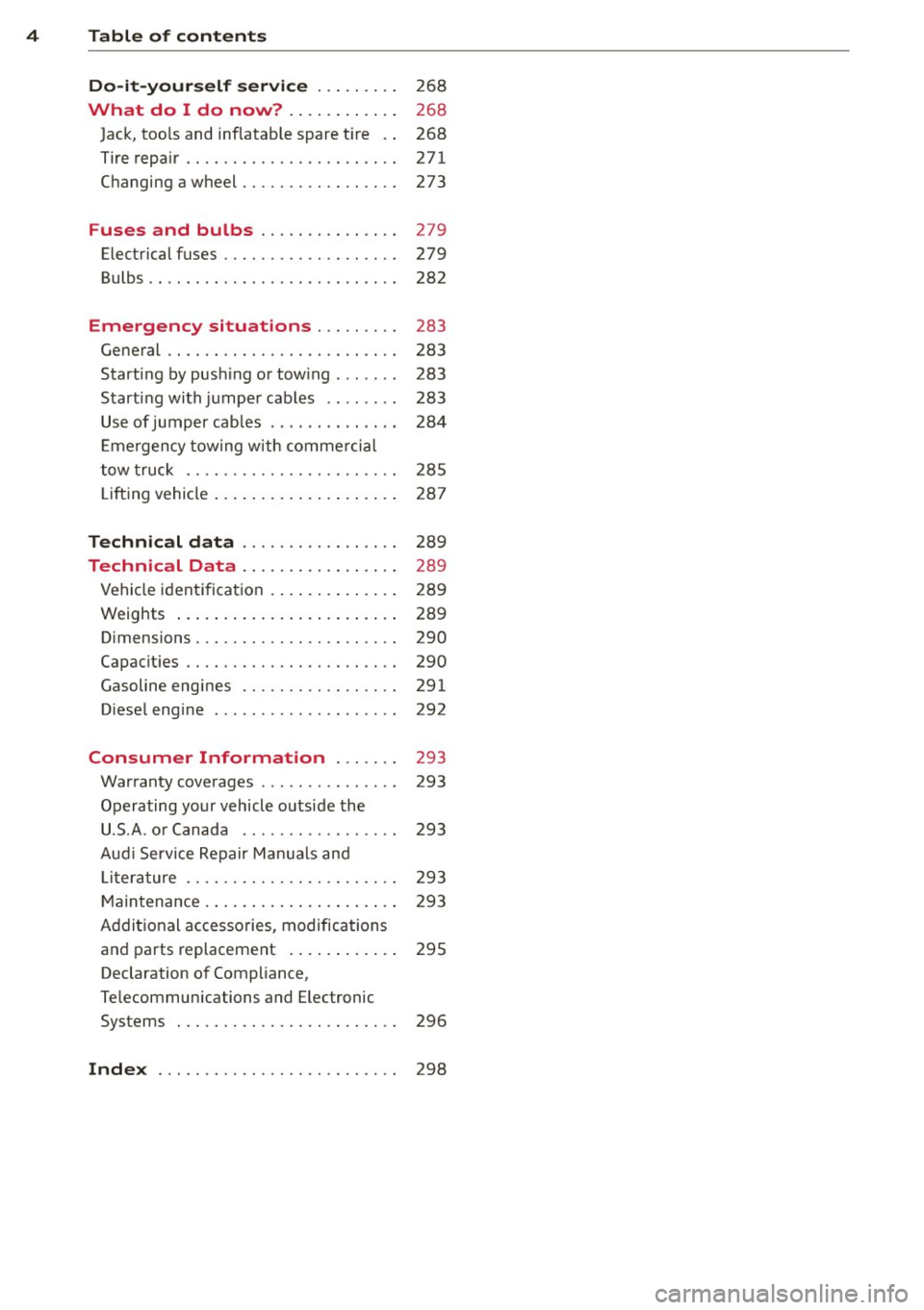
4 Table of contents
Do-it-yourself ser vice . . . . . . . . .
268
What do I do now? . . . . . . . . . . . . 268
Jack, too ls and inflatab le spare t ire . . 268
Tire repair............... .. .. .... 271
Changing a wheel . . . . . . . . . . . . . . . . . 273
Fuses and bulbs . . . . . . . . . . . . . . . 279
Electrical fuses . . . . . . . . . . . . . . . . . . . 279
Bulbs .. .... ... .. ..... ... .. .... .. 282
Emergency situations . . . . . . . . . 283
General . . . . . . . . . . . . . . . . . . . . . . . . . 283
Starting by pus hing or tow ing . . . . . . . 283
Start ing with jumper cab les . . . . . . . . 283
Use of jumper cab les . . . . . . . . . . . . . . 284
E mergency towing with comme rcial
tow truck . . . . . . . . . . . . . . . . . . . . . . . 28 5
L ift ing vehicle . . . . . . . . . . . . . . . . . . . . 287
Technical data . . . . . . . . . . . . . . . . . 289
Technical Data .. .... ... .. .. .. .. 289
Vehicle ident ificat ion . . . . . . . . . . . . . . 289
Weights . . . . . . . . . . . . . . . . . . . . . . . . 289
Dimensions. . . . . . . . . . . . . . . . . . . . . . 290
Capacit ies . . . . . . . . . . . . . . . . . . . . . . . 290
Gasoline engines . . . . . . . . . . . . . . . . . 291
Diese l eng ine . . . . . . . . . . . . . . . . . . . . 292
Consumer Information . . . . . . . 293
Warranty coverages . . . . . . . . . . . . . . . 293
Operating your vehicle outside the
U.S .A . o r Canada . . . . . . . . . . . . . . . . . 293
Audi Service Repair Man uals and
L it erature . . . . . . . . . . . . . . . . . . . . . . . 293
M aintenance . . . . . . . . . . . . . . . . . . . . . 293
Additional accessories , modifications
and parts replacement . . . . . . . . . . . . 295
Declaration of Compliance,
Te lecommunications and E lectronic
Systems . . . . . . . . . . . . . . . . . . . . . . . . 296
Index . . . . . . . . . . . . . . . . . . . . . . . . . . 298
Page 47 of 316

-Always ensure that no one is with in
range of the rear lid when it is mov ing, in
particular close to the h inges and the up
per and lower edges - fingers or hands
can be p inched.
- To help prevent po isonous exhaust gas
from being drawn into the vehicle, al
ways keep the rear lid closed while dr iv
ing. Never transport objects larger than
those which fit comp letely into the lug
gage are a, because then the rear lid can
not be fully closed.
- Never leave you r vehicle unattended es
pecially wi th the rear lid left open. A
child could crawl into the car through the
luggage compartment and pull the lid
shut, becom ing trapped and unab le to
get out. To reduce the risk of persona l in
jury, never let children p lay in or around
your vehicle . A lways keep the rear lid as
well as the vehicle doors closed when not in use.
- If there is a luggage rack or bicycle rack mounted on the rear lid, it may not be
able to open completely or an opened
rear lid may close by itself because of the
added weight . So t he open rear lid must
be s upported or the weight must be re
moved from the luggage rack first .
(1) Tips
-As soon as the electrical connection to
the trailer socket is completed on
vehicles with a factory installed tow ing
hitch, or a trailer hitch that was installed
l ater according to factory spec ifications,
the automatic rear lid function can only be operated via the handle in the rear lid.
- If the vehicle battery charge drops below
a certain level, you can still open or close
the rear lid manually, however, you will
need to apply more force to close it .
- If the rear lid on a locked vehicle is un
locked with the m iddle button
c::; on the
remote key, the rear lid is automatically
l ocked again immediately after clos ing .
This is in dicated by the tu rn signals
bl inking .
Openin g an d clos ing 45
- The following applies to vehicles equip
ped with the Convenience key* feature: if
the remote control key is left in the lug
gage compartment, luggage compart
ment w ill automatically unlock itself af
ter you lock the vehicle . Th is prevents
you from unintentionally lock ing you r
key in the luggage compartment.
Emergency unlocking
of the luggage
compartment lid
The luggage compartment lid can be released
in an emergency from the inside .
Fig. 38 Luggage compartment lid interior
The luggage compa rtmen t lid can be released
i n an emergency from ins ide the luggage com
partment.
~ Remove the cover from the luggage com
partment lid .
~ Press the lever in the direction o f the a rrow
until the luggage compartment lid releases.
Page 70 of 316
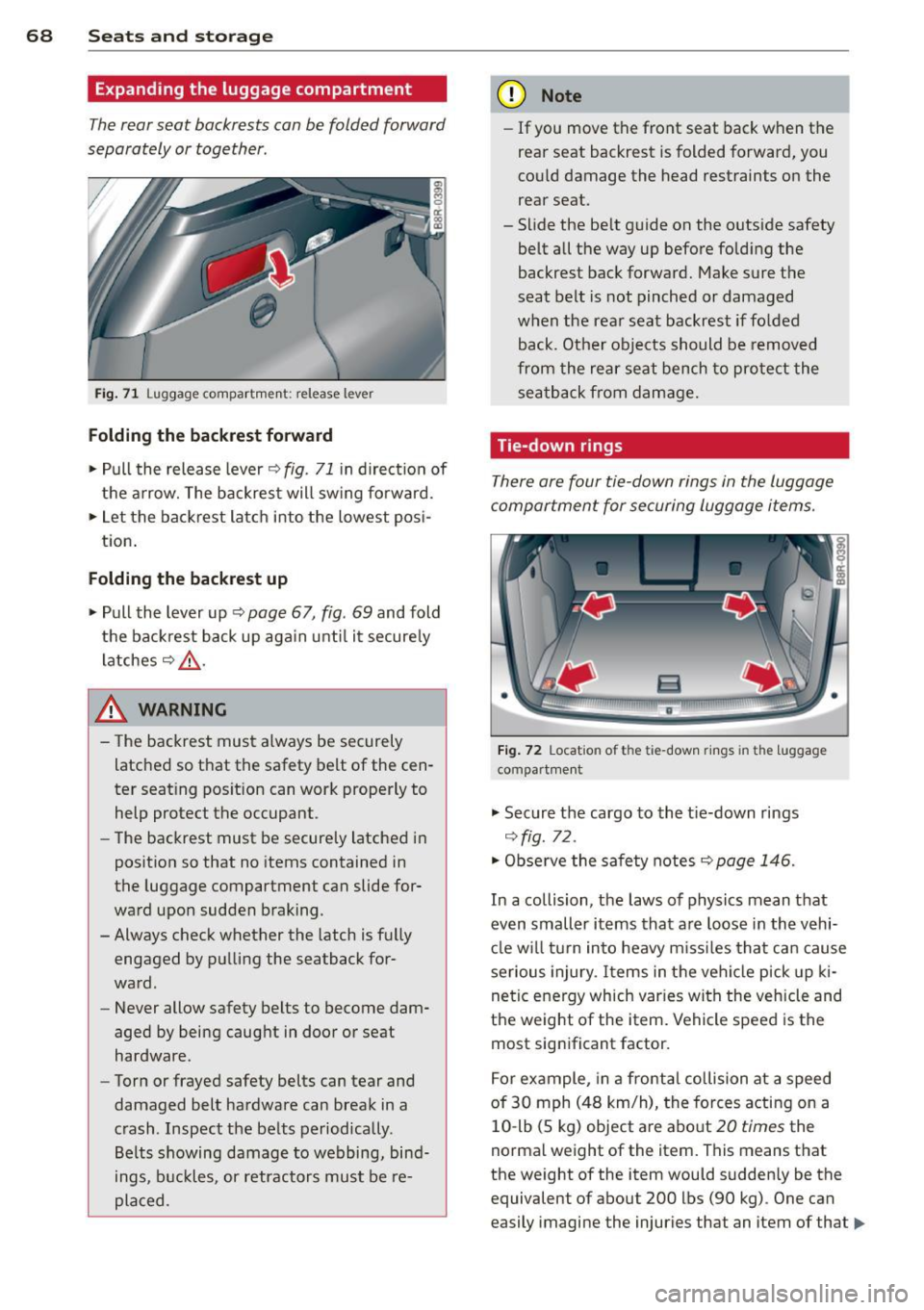
68 Seats and storage
Expanding the luggage compartment
The rear seat backrests can be folded forward
separately or together.
Fi g. 71 Luggage compartment: release lever
Folding the backrest forward
~ Pull the release lever~ fig. 71 in d irect ion of
the a rrow. The backrest will sw ing forward.
~ Let the backrest latch into the lowest pos i
tion .
Folding the backrest up
~ Pull the lever up ¢ page 67, fig. 69 and fold
the backrest back up aga in unti l it securely
latches~ .&_.
A WARNING
-
-The backrest must a lways be securely
latched so that the safety belt of the cen
ter seat ing pos ition can work properly to
help protect the occupant .
- The backrest must be securely latched in
position so that no items contained in
the luggage compartment can slide for
wa rd upon sudden braking .
-Always check whether the latch is fu lly
engaged by p ulling the seatback for
ward .
- Never allow safety belts to become dam
aged by being caught in doo r or seat
hardware.
- Torn or frayed safety belts can tear and
damaged belt hardware can break in a
crash . Inspect the be lts periodically.
Belts showing damage to webbing, bind
ings, b uckles, or retractors must be re
placed .
(D Note
-If you move the front seat back when the
rear seat backrest is folded forward, you
cou ld damage the head restraints on the
rear seat.
- Slide the be lt guide on the outside safety
belt all the way up before folding the
backrest back forward. Make sure the
seat belt is not pinched or damaged
when the rea r seat backrest if folded
back. Other objects should be removed
from the rear seat bench to protect the sea tback from damage.
Tie-down rings
There are four tie-down rings in the luggage
compartment for securing Luggage items.
Fig. 72 Locatio n of the tie-dow n rin gs in the luggage
compart men t
~ Secure the cargo to the t ie-down rings
~ fig. 72 .
~ Observe the safety notes ~ page 146.
In a collision, the laws of physics mean that
even smaller items that a re loose in the vehi
cl e w ill turn into heavy m iss iles that can cause
serious injury. Items in the vehi cle pick up ki
netic e nergy which var ies with the vehicle and
the weight of the item. Vehicle speed is the
most significant factor.
F or example, in a fronta l collision at a speed
of 30 mph (48 km/h), the forces acting on a
10 -lb (S kg) object are abo ut
20 times the
normal weight of the item. This means that
the weight of the item would sudden ly be the
equivalent of about 200 lbs (90 kg). One can
easily imagine the injuries that an item of that""
Page 71 of 316
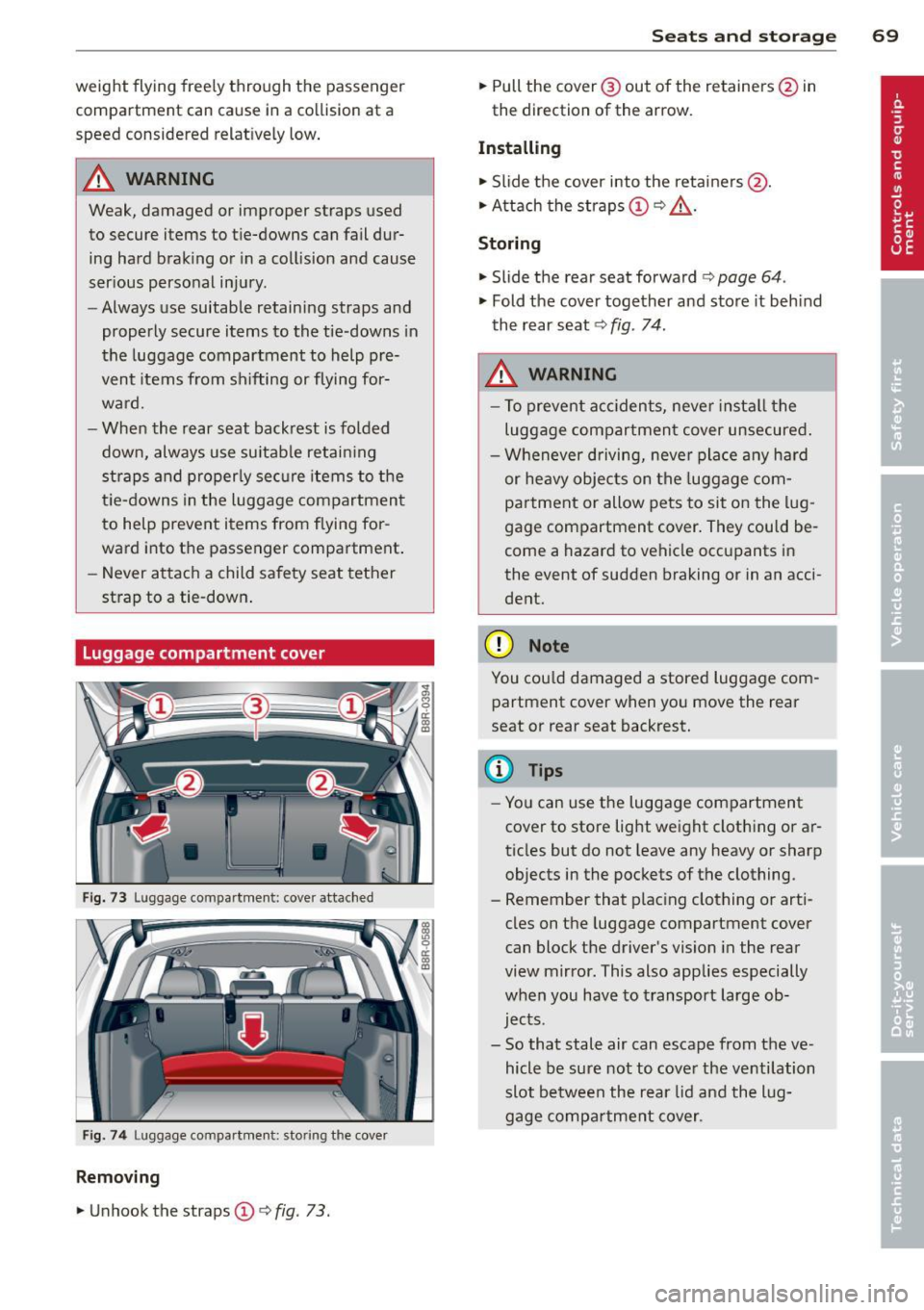
weight flying freely through the passenger
compartment can cause in a co llision at a
speed considered relatively low .
.&_ WARNING
Weak, damaged or improper straps used
to secure items to tie-downs can fail dur
ing hard brak ing or in a collision and cause
ser ious personal injury.
- Always use suitable retaining straps and
properly secure items to the tie-downs in
the luggage compartment to help pre
vent items from sh ifting or flying for
wa rd.
- When the rear seat backrest is folded down, always use su itab le retain ing
straps and properly sec ure items to the
t ie-downs in the luggage compartment
to help prevent items from flying for
ward into the passenger compartment .
- Never attach a child safety seat tether
strap to a tie -down .
Luggage compartment cover
Fig. 73 Luggage compartme nt: cover attac hed
Fig . 7 4 Luggage compartment: stor ing the cover
Removing
.. Unhook the straps(!)¢ fig. 73.
Sea ts a nd s to rage 69
.. Pull the cover@ out of the retainers @in
the direction of the arrow.
Installing
.. Slide the cover into the retainers @ .
.. Attach the straps(!)¢,& .
Storing
.. Slide the rear seat forward ¢ page 64.
.. Fold the cover together and store it beh ind
the rear seat¢
fig. 74.
.&_ WARNING
- To prevent acc idents, never instal l the
luggage compartmen t cover unsecured .
- Whenever driving, neve r pla ce any hard
or heavy objects on the luggage com
partment or allow pets to sit on the lug
gage compartment cover. They could be
come a hazard to vehicle occ upants in
the event of sudden braking or in an acci
dent.
(D Note
You cou ld damaged a stored luggage com
partment cover when you move the rear
seat or rear seat backrest.
(D Tips
- You can use the luggage compartment
cover to store light weight clothing or ar
ticles but do not leave any heavy or sharp
objects in the pockets of the clothing.
- Remember that plac ing clothing or arti
cles on the luggage compartment
cover
can block the driver's vision in the rear
view mirror. This also applies especially
when you have to transport large ob
jects.
- So that stale air can escape from the ve
hicle be su re not to cove r the ventilation
slot between the rear lid and the lug
gage compa rtment cover.
-
Page 74 of 316
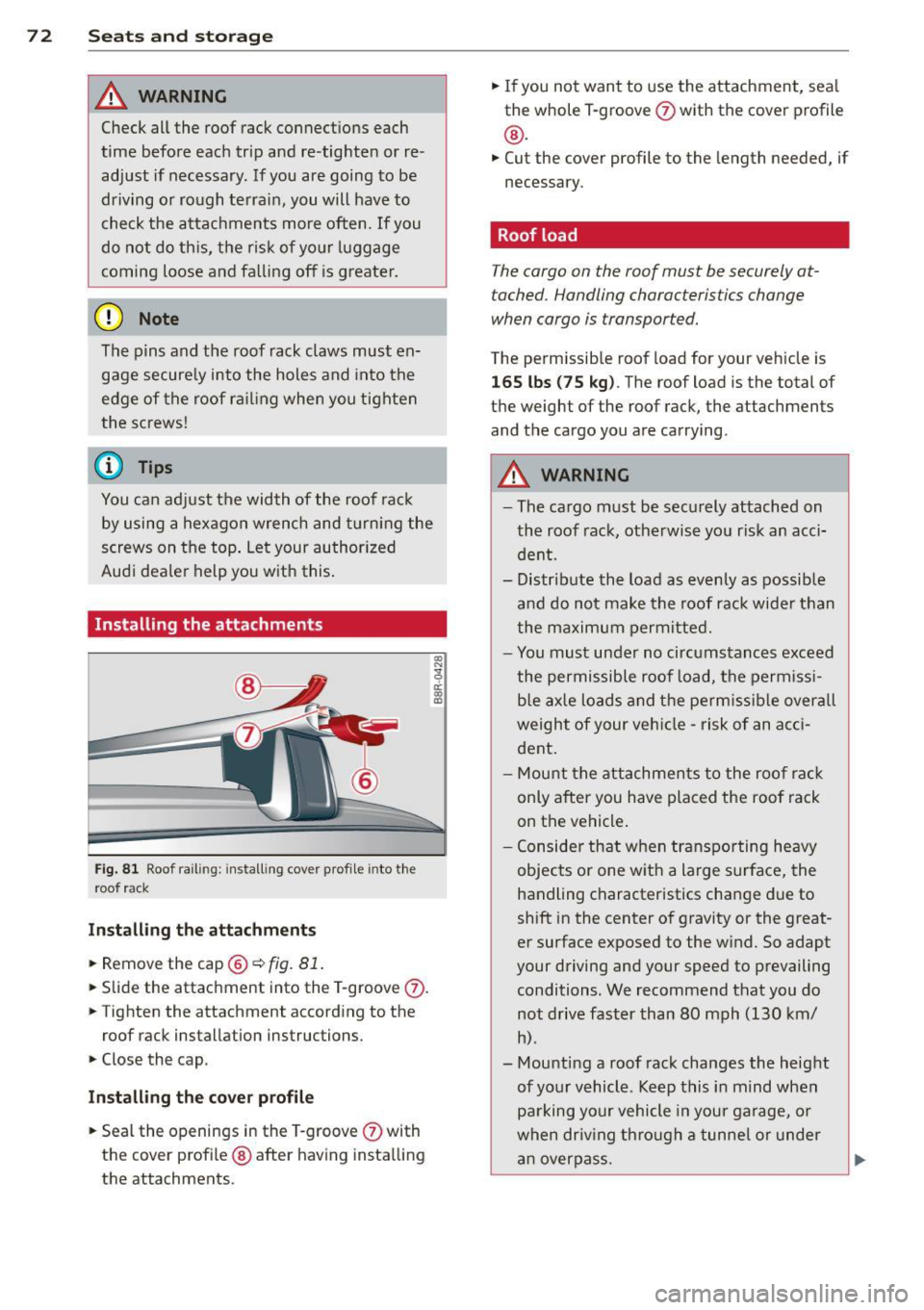
7 2 Seats and storage
A WARNING
Check all the roof rack connect ions each
time before eac h tr ip and re -tighten or re
adjust if necessary. If you are going to be
driving or rough terra in, you will have to
check the at tachments more often.
If you
do not do th is, the risk of yo ur luggage
coming loose and fa lling off is greater.
The p ins and the roof rack claws must en
gage secure ly into the holes and in to the
edge of the roof ra iling when you tighten
the screws!
(j) Tips
You can adjust the width of the roof rac k
by using a hexagon wrench and turning the
screws on t he top . Let your author ized
Audi dea ler help you with this .
Installing the attachments
Fig. 81 Roof railin g: in stall ing cov er profile into th e
r oo f ra ck
In stall ing the attachm ents
... Remove the cap@¢ fig. Bl .
... Slide the attachment into the T-groove (i) .
... Tighten the attachment accord ing to the
roof rack installation instructions.
... Close the cap.
I n stall ing th e cover p rofile
... Seal the openings in the T-groove 0 with
the cover profi le @ after having insta lling
the attachments.
., N ;g
er .,
'° ...
If you not want to use the attachment , sea l
the whole T-groov e
(i) with the cover profil e
®·
... Cut the cover profile to the length needed, if
necessa ry .
Roof load
The cargo on the roof must be securely at
tached. Handling charac teristics change
when cargo is transpor ted.
The permissib le roof load for your veh icle is
165 lbs (75 kg ). The roof lo ad is the total of
the weight o f the roof rack, the attachment s
and the cargo you are carrying .
A WARNING
-The cargo m ust be sec urely attached on
the roof rack, otherwise you ris k an acci
dent.
- Distrib ute the load as evenly as possib le
and do not make the roof rack wider than
the maximum permitted.
- You must under no circ umstances exceed
the permissible roof load, the permiss i
b le ax le loads a nd the pe rm issib le over all
weight of your veh icle -risk of an acc i
dent .
- Mou nt t he attachments to the roo f ra ck
only after you have placed the roof rack
on the vehicle .
- Consider that when tra nspo rting heavy
objects or one w ith a large s urface, the
handling characteristics change due to
shift in the center of gravity or the great
er surface exposed to the w ind . So adapt
your driving and your speed to prevailing
conditions . We recommend that you do
not drive faster than 80 mph (130 km/
h) .
- Mounti ng a roof rack changes the heig ht
of your vehicle . Keep this in mind when
parking your vehicle in your ga rage, o r
when dr iv ing t hrough a tunne l o r u nder
a n overpass.
~
Page 78 of 316
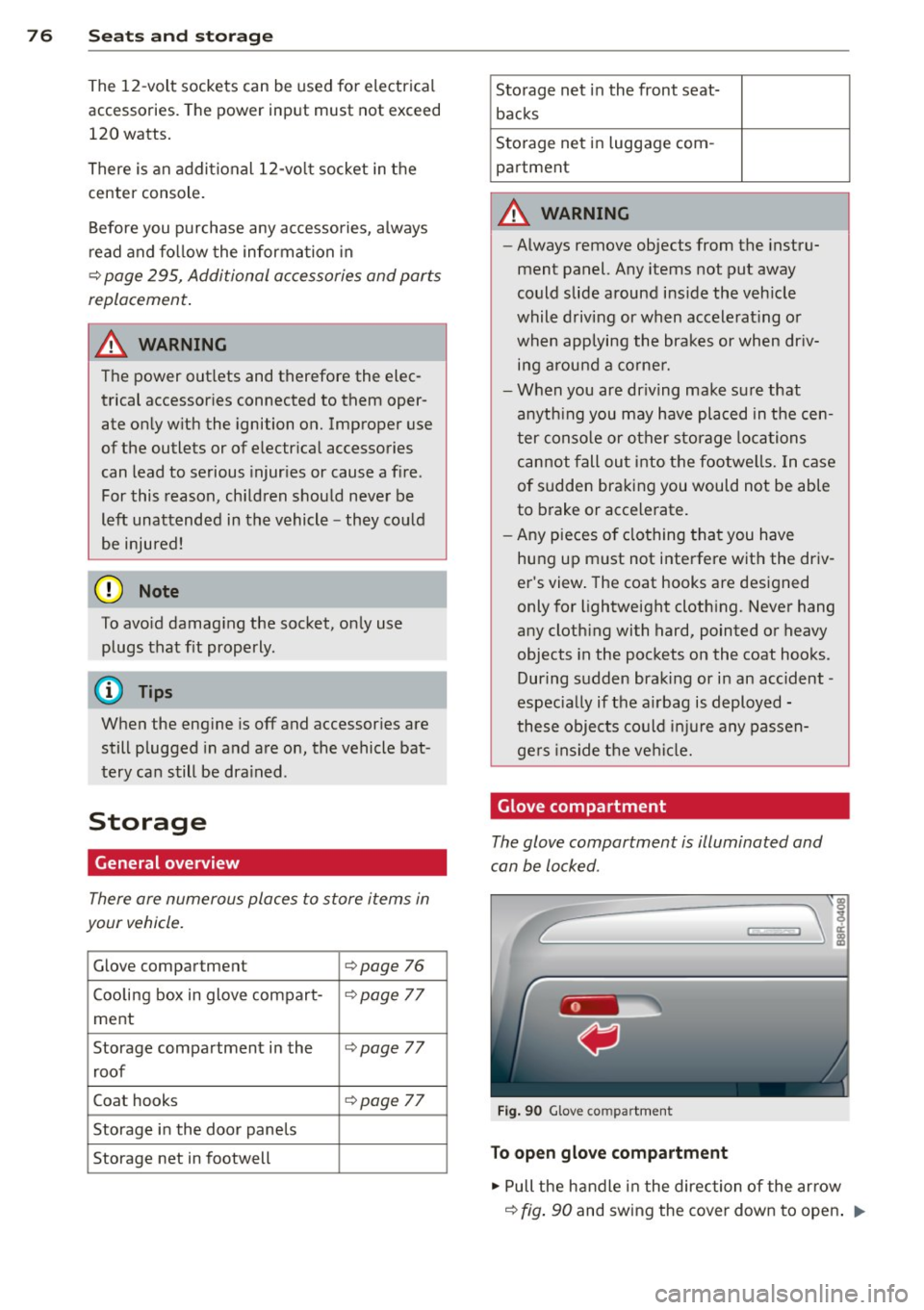
76 Seats and storage
The 12-volt sockets can be used for electrical
accessories. The power input must not exceed
120 watts.
There is an additional 12-volt socket in the
center console. Before you purchase any accessories, always
read and follow the information in
Q page 295, Additional accessories and parts
replacement.
A WARNING
The power outlets and therefore the elec
trical accessories connected to them oper ate only with the ignition on. Improper use
of the outlets or of electrical accessories
can lead to serious injuries or cause a fire.
For this reason, children should never be
left unattended in the vehicle -they could
be injured!
(D Note
To avoid damaging the socket, only use
plugs that fit properly .
{D) Tips
When the engine is off and accessories are
still plugged in and are on, the vehicle bat
tery can still be drained .
Storage
General overview
There are numerous places to store items in
your vehicle.
Glove compar tment Q page 76
Cooling box in glove com part-Qpage 77
ment
Storage compartment in the
Qpage 77
roof
Coat hooks
Qpage 77
Storage in the door panels
Storage net in footwell
-
Storage net in the front seat- backs
Storage net in luggage com- partment
A WARNING
--
- Always remove objects from the instru
ment panel. Any items not put away
could slide around inside the vehicle
while driving or when accelerating or
when applying the brakes or when driv ing around a corner.
- When you are driving make sure that
anything you may have placed in the cen
ter console or other storage locations
cannot fall out into the footwells. In case
of sudden braking you would not be able
to brake or accelerate.
- Any pieces of clothing that you have
hung up must not interfere with the driv
er's view. The coat hooks are designed
only for lightweight clothing. Never hang
any clothing with hard, pointed or heavy
objects in the pockets on the coat hooks .
During sudden braking or in an accident -
especially if the airbag is deployed -
these objects could injure any passen
gers inside the vehicle.
Glove compartment
The glove compartment is illuminated and
can be locked .
Fig. 90 Glove co mpartm ent
To open glove compartment
.,. Pull the handle in the direction of the arrow
Q fig. 90 and swing the cover down to open . ..,.
Page 79 of 316
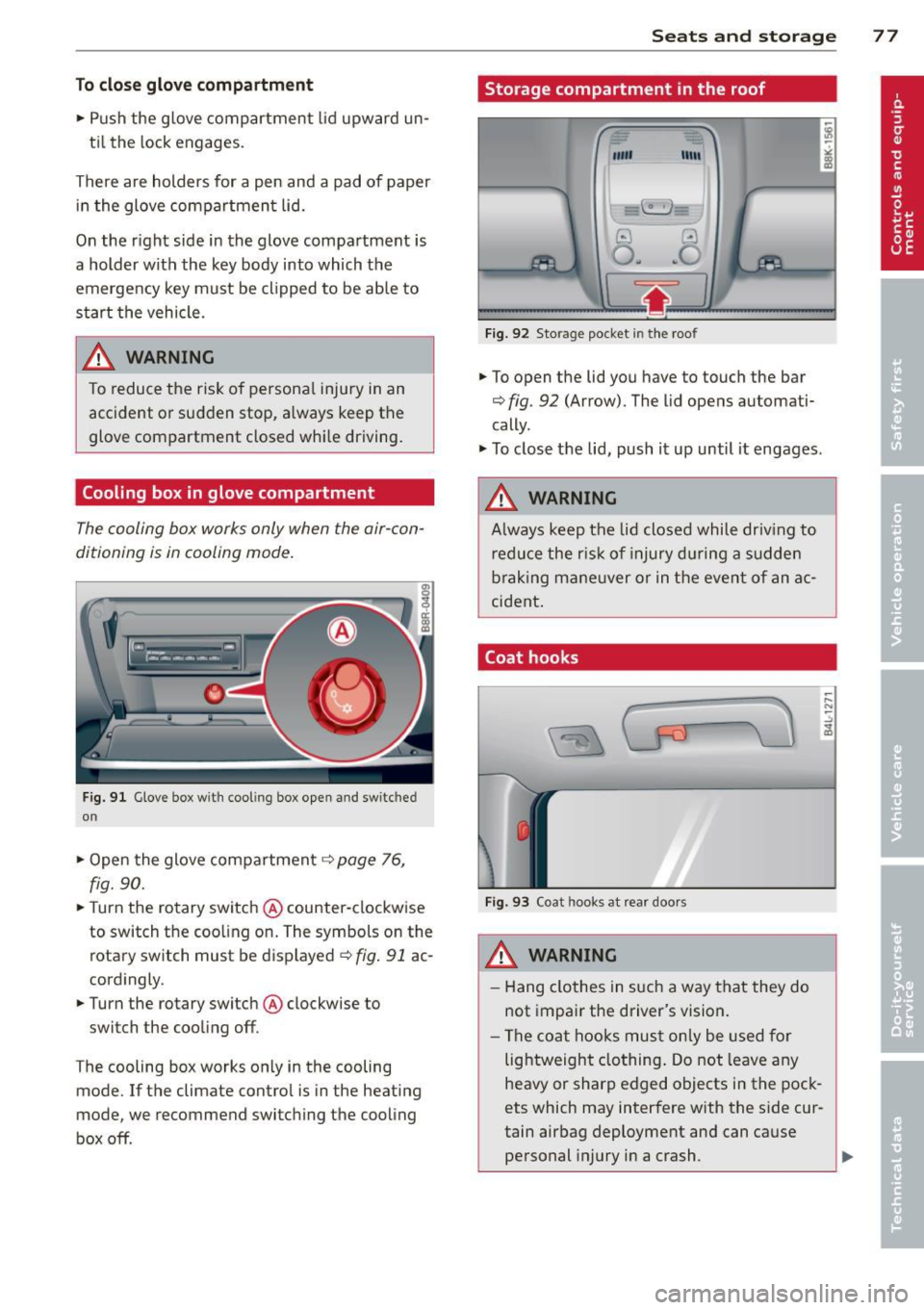
To close glove compartment
• Push the g love compartment lid upward un-
ti l the lock engages.
There are holders for a pen and a pad of paper in the glove compartment lid.
On the right side in the glove compartment is
a holder with the key body into which the
emergency key must be cl ipped to be able to
start the vehicle .
A WARNING
To reduce the risk of personal injury in an
accident or sudden stop, a lways keep the
glove compartment closed whi le driving.
Cooling box in glove compartment
The cooling box works only when the air-con
ditioning is in cooling mode.
Fig. 91 Glove box w ith cool ing box open and switc hed
on
" Open the glove compartment c::> page 76,
fig. 90.
"T urn the rotary switch @ counter-clockwise
to switch the coo ling on. The symbols on the
rotary switch must be displayed
c::> fig. 91 ac
cordingly .
• Turn the rotary switch @ clockwise to
switch the cooling off .
T he cooling box works only in the cooling
mode. If the climate contro l is in the heating
mode, we recommend switching the cooling
box off .
Seats and storage 77
Storage compartment in the roof
""'
11111
Fig. 92 Storage pocket in the roof
.. To open the lid you have to touch the bar
c::> fig . 92 (Arrow). The lid opens automati
cally .
" To close the lid, push it up until it engages .
A WARNING
Always keep the lid closed while driv ing to
reduce the risk of injury during a sudden
braking maneuver or in the event of an ac
cident .
Coat hooks
Fig. 93 Coat hooks at rear doors
_& WARNING
- Hang clothes in such a way that they do
not impair the driver's vision.
- The coat hooks must only be used for
lightweight clothing. Do not leave any
heavy or sharp edged objects in the pock
ets which may interfere with the side cur
tain airbag deployment and can cause personal injury in a crash .
Page 92 of 316
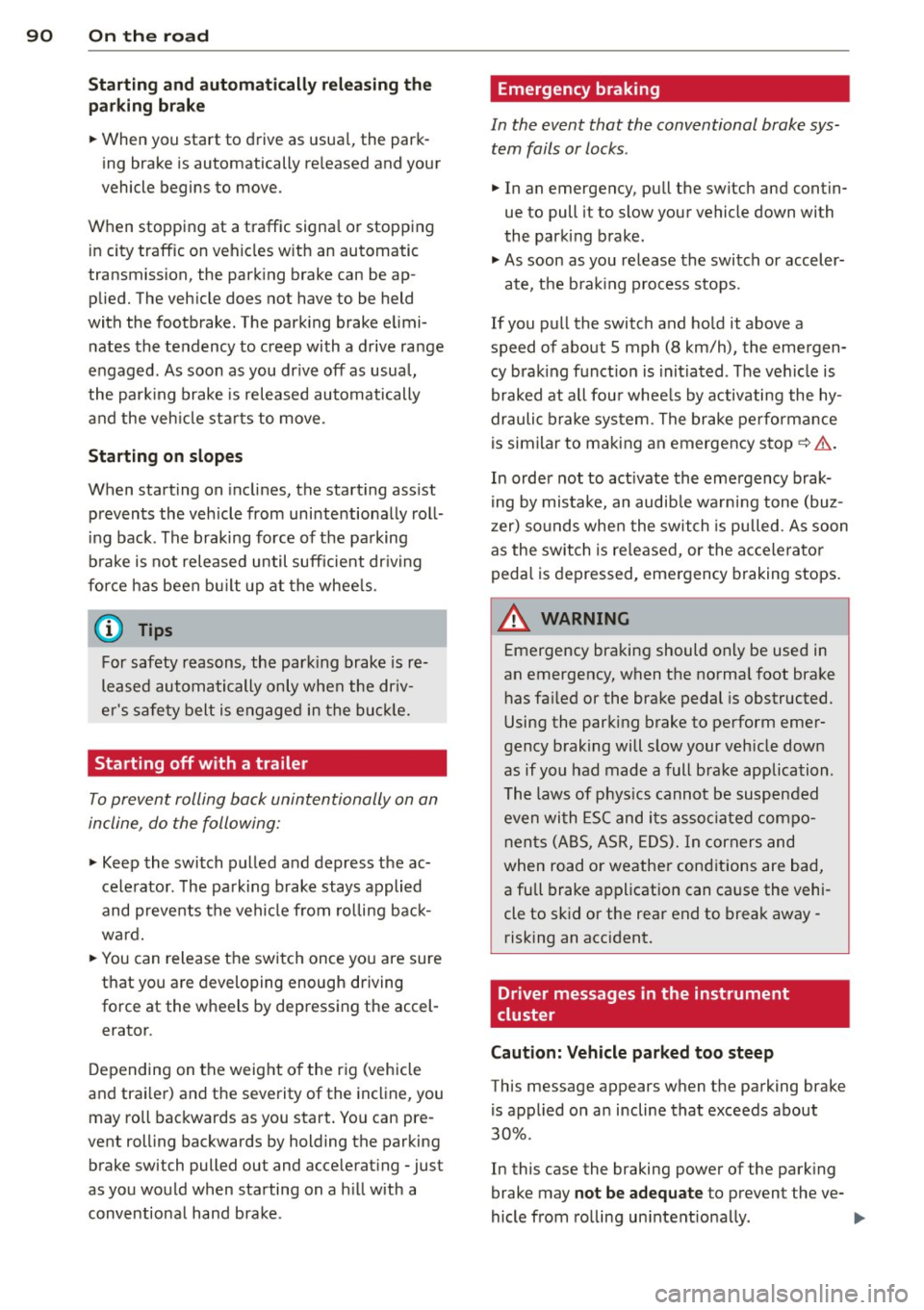
90 On the road
Startin g and automati cally r ele a s ing the
p ark ing b rake
.. When you start to drive as usua l, the park
ing brake is automatically re leased and your
vehicle begins to move.
When stopping at a traffic signa l or stopping
in city traffic on vehicles with an automatic
transmission, the park ing brake can be ap
plied. The vehicle does not have to be held
with the footbrake. The park ing brake elimi
nates the tendency to creep with a drive range
engaged . As soon as you dr ive off as usual,
the park ing brake is released automatically
and the veh icle starts to move .
Starting on slopes
When starting on incline s, the start ing ass ist
prevents the vehicle from unintentionally roll
ing back. The braking force of the parking
b rake is not released until sufficient dr iving
fo rce has been bu ilt up at the whee ls.
(D Tips
For safety reasons, the park ing brake is re
leased automatically only when the dr iv
er 's safety belt is engaged in the bu ck le.
Starting off with a trailer
To prevent rolling back unintentionally on an
incline, do the following:
.. Keep the switch pulled and depress the ac
celerator. The parking brake stays applied
and prevents the vehicle from ro lling back
ward.
.. You can release the switch once you are sure
th at you are developing enough driving
force at the wheels by depressing the accel
erator.
Depending on the weight o f the rig (vehicle
and trai ler) and the severity of the incline , you
may roll backwards as you start . Yo u can pre
vent roll ing backwards by holding the parking
brake switch pulled out and acce lerat ing -just
as you would when starting on a h ill with a
conventional hand brake .
Emergency braking
In the event that the conventional brake sys
tem fails or locks .
.. In an emergency, pull the switch and contin
ue to pull it t o slow your vehicle down with
the parking brake .
.. As soon as you release the switch or acceler-
ate, the b rak ing process stops .
If you pull the switch and ho ld it above a
speed of about 5 mph (8 km/h), the emergen
cy brak ing f unct ion is init iated . T he veh icle is
braked at all fou r whee ls by activating the hy
draulic brake sys tem. The brake performance
is similar to making an emergency stop~&. .
In order not to act ivate the emergency brak
ing by mis take, an audib le warning tone (buz
zer) sounds whe n the switch is pulled. As soon
as the switch is re leased, or the accelerator
peda l is depressed, emergency braking stops.
A WARNING
Emergency braking should only be used in
an emergency, when the norma l foot brake
has fa iled or the brake pedal is obstructed.
Using the park ing brake to perform emer
gency braking will s low your veh icle down
as if you had made a full brake application .
The laws of phys ics cannot be suspended
even with ESC and its asso ciated compo
nents (ABS, ASR, EDS). In corners and
when road or weather cond itions are bad,
a full brake application can ca use the vehi
cle to skid or the rear end to break away -
risking an accident .
Driver messages in the instrument
cluster
Caution: Vehicle parked too steep
This message appears when the parking brake
is app lied on a n incline that exceeds about
30% .
In this case the braking power of the park ing
brake may
not b e adequate to prevent the ve-
hicle from ro lling un intent io na lly. ...
Page 147 of 316

Stowing luggage
Loading the luggage compartment
All luggage and other objects must be prop
erly stowed and secured in the luggage com
partment.
Fig . 153 Safe load pos ition ing: place heavy objects as
low and as far forward as possible.
Loose items in the luggage compartment can
shift suddenly, changing vehicle handling
characteristics . Loose items can also increase
the r isk of serious personal injury in a sudden
veh icle maneuver or in a collision .
~ Distribute the load evenly in the luggage
compartment.
~ Always place and properly secure heavy
items in the luggage compartment as low
and as far forward as poss ible
<=> fig. 153.
~ Secure luggage using the tie-downs provid
ed
¢ page 68.
~ Make sure that the rear seatback is securely
latched in place.
A WARNING
Improperly stored luggage or other items
can fly through the vehicle causing serious
personal injury in the event of hard brak
ing or an acc ident. To help reduce the risk
of serious personal injury:
- Always put objects, for example, luggage
or other heavy items in the luggage com
partment.
- Always secure objects in the luggage
compartment us ing the tie-down eye lets
and suitable straps .
Drivin g Sa fely 145
A WARNING
Heavy loads will influence the way your ve
h icle handles. To help reduce the risk of a
loss of control leading to serious personal
injury:
-Always keep in mind when transporting
heavy objects, that a change in the cen
ter of gravity can also cause changes in
veh icle handling:
- Always distribute the load as evenly as
possible.
- Place heavy objects as far forward in
the luggage compartment as possible.
- Never exceed the Gross Axle Weight Rat
ing or the Gross Vehicle Weight Rating
specified on the safety compliance stick
er on the left door jamb. Exceeding per
missible weight standards can cause the
veh icle to slide and handle differently.
- Please observe information on safe driv
ing<=>
page 139 .
A WARNING
To help prevent poisonous exhaust gas
from being drawn into the vehicle, a lways
keep the rear lid closed while driving.
- Never transport objects larger than
-
those fitting comp letely into the luggage
area because the rear lid cannot be fu lly
closed.
- If you absolutely must dr ive with the rear
lid open, observe the following notes to
reduce the risk of poisoning:
- Close all windows,
- Close the Panoramic sliding sunroof *,
- Open all air outlets in the inst rument
panel,
- Switch off the air rec irculat ion,
- Set the fresh a ir fan to the highest
speed.
A WARNING
A lways make sure that the doo rs, all win
dows, the Pano ramic s liding sunroof* and
the rear lid are securely closed and locked
Page 148 of 316

146 Driving Safel y
to reduce the risk of inj ury when the vehi
cle is not be ing used.
- After closing the rear lid, always make
sure that it is properly closed and locked.
- Never leave your vehicle unattended es
pecially with the rear lid left open . A
child could crawl into the vehicle through
the luggage compartment and close the
rear lid becoming trapped and unable to
get out . Be ing trapped in a vehicle can
lead to serious persona l injury.
- Never let children p lay in or around the
vehicle .
- Never let passengers r ide in the luggage
compartment . Veh icle occupan ts must
always be proper ly restrained in one of
the vehicle's seating positions.
(D Tips
- Air circulation helps to reduce window
fogging . Sta le air escapes to the o utside
th rough vents in the trim pane l. Be su re
to keep these slots free and open.
- The tire pressure must correspond to the
load . The t ire pr essure is shown on the
tire p ressu re label. The tire pressure la
bel is loc ate d on the driver's s ide B-pi lla r.
The tire pressure label lists the recom
men ded cold t ire inflat ion pressu res for
the veh icle at its maximum capacity
weight and the tires that were on your
vehicle at the time it was manufact ured.
For recommended t ire pressures for nor
mal load conditions, please see chapter
Q page 251.
Tie-downs
The luggage compartment is equipped with
four tie-downs to secure luggage and other
items .
Use the tie-downs to secure your cargo prop
erly ¢ page 145, Loading the luggage com
partment .
In a coll is ion, the laws of phys ics mean that
even smaller items that are loose in the vehi
cle will become heavy missiles that can cause se
rious injury. Items in t he vehi cle possess en
ergy which vary with vehicle speed and the
weight of t he item . Vehicle speed is the most
s ignificant factor.
F or example, in a frontal collision at a speed
of 30 mph (48 km/h), the forces acting on a 10 -lb (5 kg) object a re abo ut 20 times the
normal weight of the item. This means that
the weight of the item would sudden ly be
about 200 lbs . (90 kg) . You can imag ine the
injur ies that a 200 lbs . (90 kg) item fly ing
fr ee ly t hro ugh the passenger compa rtment
cou ld cause in a col lision like this.
_& WARNING
We ak, damaged or imprope r straps used
to secure items to tie-downs can fail dur
i ng hard braking or in a collision and cause
se rious pe rsonal injury.
-Always use s uita ble mo unt ing straps an d
p roperly secu re items to the tie-downs in
the l uggage compa rtment to he lp pre
vent items from shift ing or fly ing fo r
ward as dangerous missiles.
- When the rea r seat backrest is folded
down, a lways use suitable mounting
straps and properly secure items to the
tie-downs in the luggage compartment
to hel p prevent items from fly ing for
ward as dangerous missiles into the pas
senger compartment.
- Never attach a chi ld safety seat t ether
s trap to a t ie-down .
Reporting Safety
Defects
Applicable to U.S.A.
If yo u b eli eve that your vehi cle
has a def ect whi ch could cau se
a crash or could cau se injury or
death, you should immediately
inform the National Highway
Traffic Safet y Administration ""